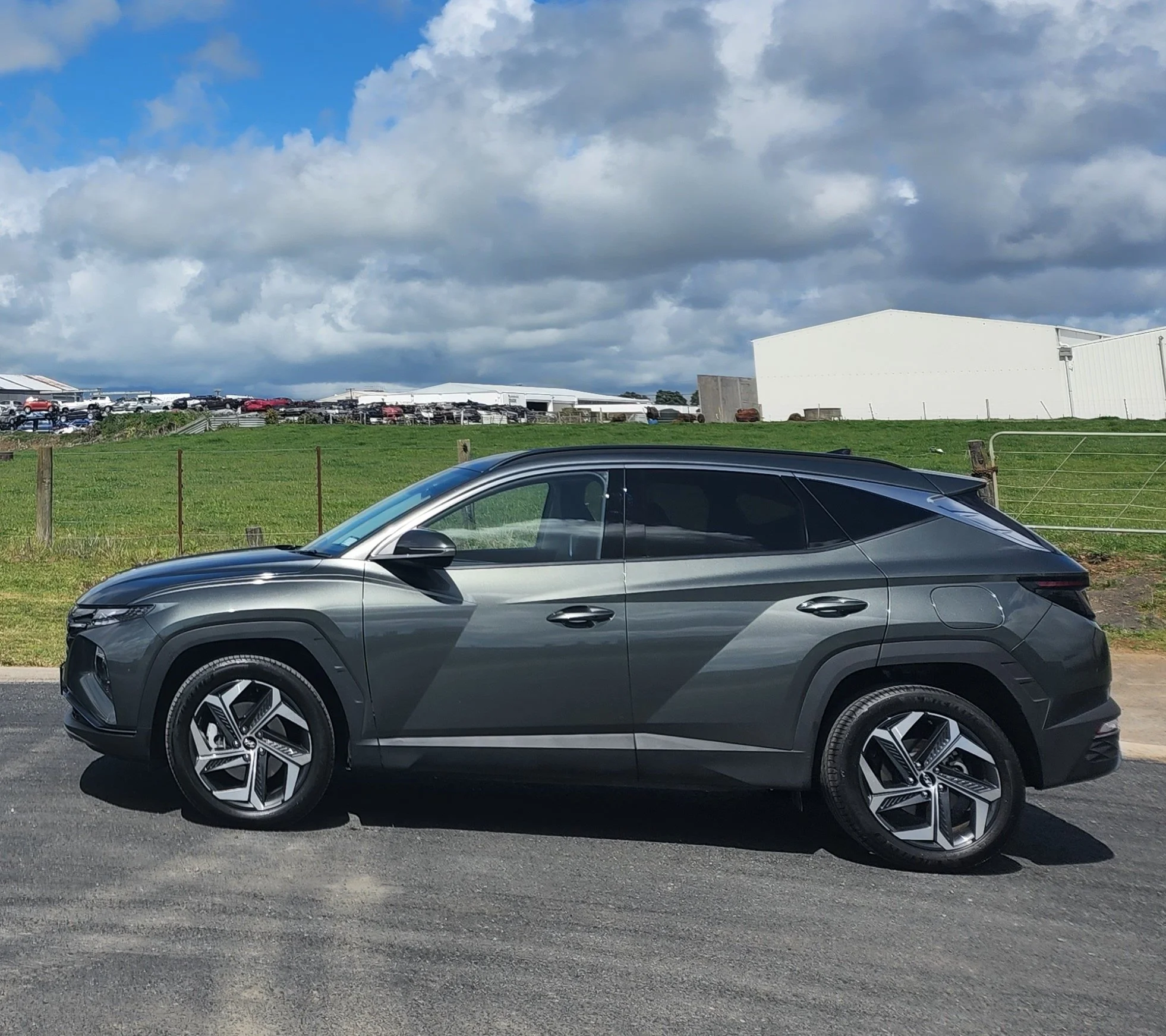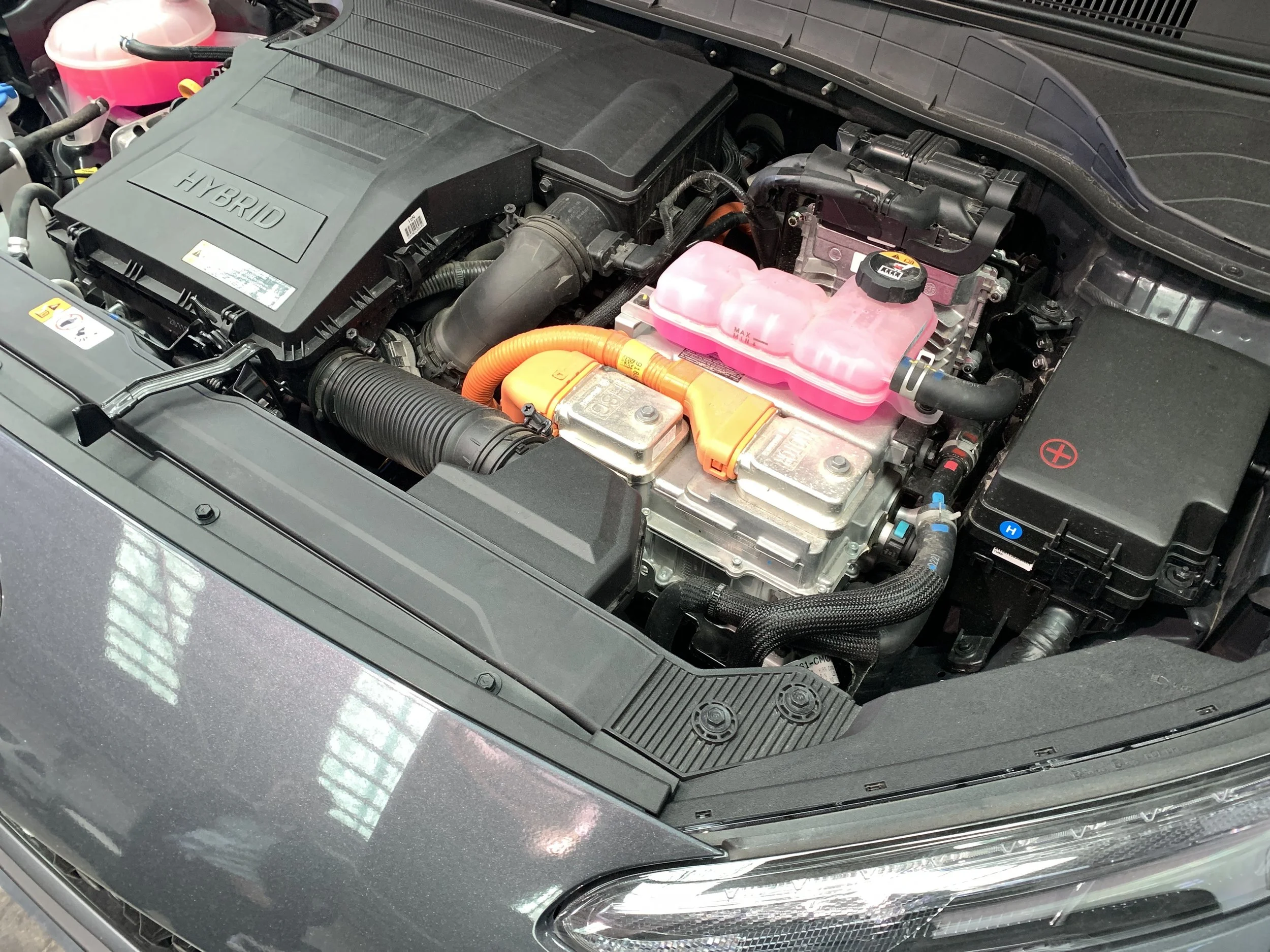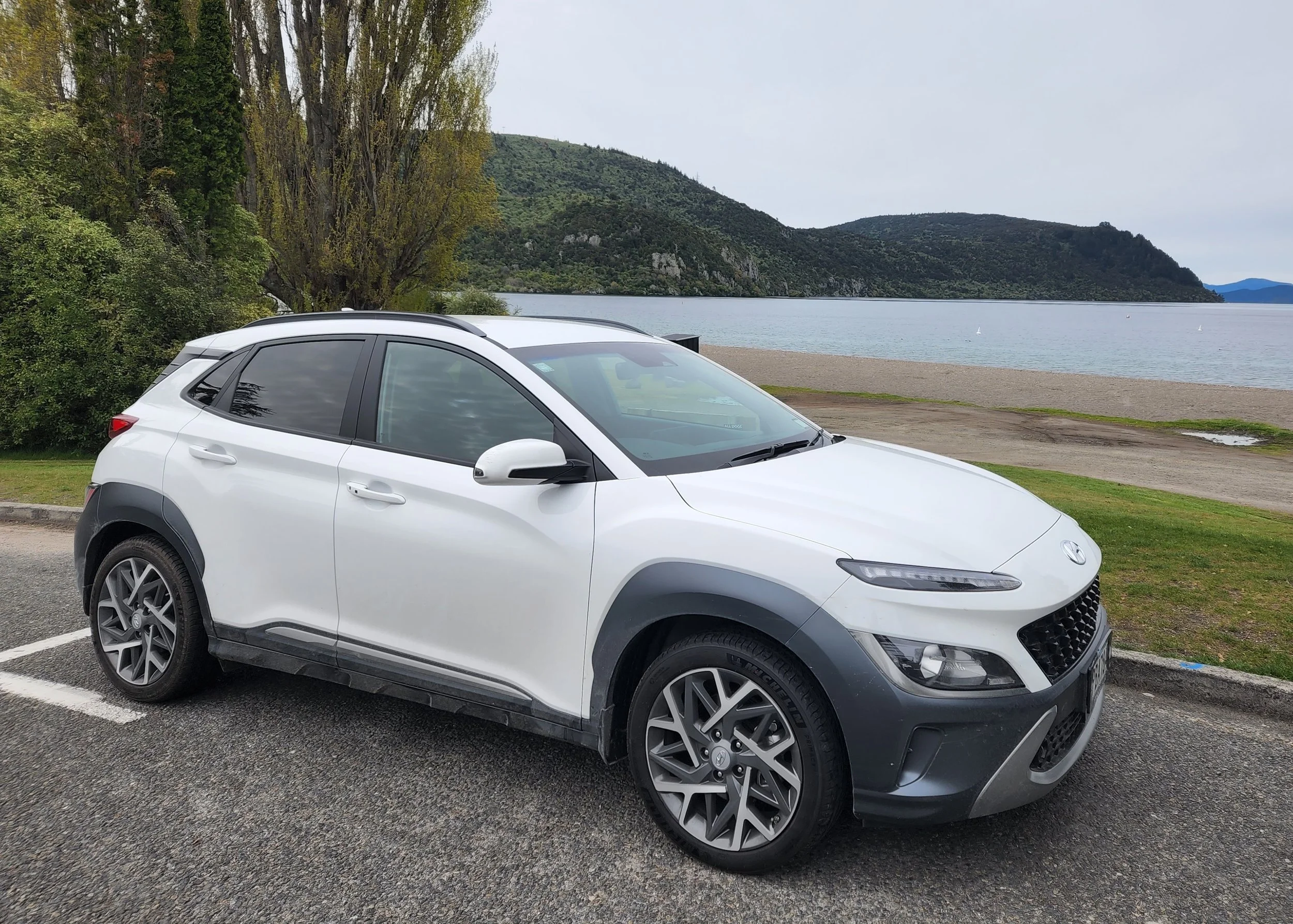Hyundai Kona, Tucson hybrids twin test review: Adding zap to zip
/How do the newly-arrived battery-assisted versions of these market favourites stack up?
Hyundai Kona hybrid 2WD Elite
Price: $51,990
Powertrain: 1580cc 77kW/147Nm four cylinder petrol engine mated to 32kW/170Nm electric motor with 1.56kWh lithium ion battery, combined output 104kW/265Nm, front-wheel drive, six-speed dual-clutch automatic, economy 4.4L/100km, 101g/km CO2.
Vital statistics: 4205mm long, 1800mm wide, 1565mm high, wheelbase 2600mm.
For: Excellent specification, Series II exterior styling, easy drive, good economy.
Against: A bit pricey when compared to combustion-engined Kona.
Hyundai Tucson hybrid 2WD Elite
Price: $61,990
Powertrain: Turbocharged 1598cc 132kW/265Nm four cylinder engine mated to 44.2kW/264Nm electric motor with 1.49kWh lithium ion battery, combined output 169kW/350Nm, front-wheel drive, six-speed automatic, economy 4.9L/100km, 111g/km CO2.
Vital statistics: 4500mm long, 1865mm wide, 1650mm high, wheelbase 2680mm.
For: Great looks, excellent specification, powerful drive, good economy.
Against: Transmission, a bit pricey when compared to ICE Tucsons.
TWELVE of the 15 most popular passenger vehicles in October offered with at least some form of electrification.
Most availed as hybrids, quite a number also extend to plug-in hybrid and fully electric provisions.
The Motor Industry Association, the organisation that acts for most of the new vehicle industry, also relates that of the 10,771 new passenger vehicles and sports utilities registered last month, close to 40 percent were electrified.
Proof, surely, that the financial effects of the Government’s feebate scheme, the cost of fuel, and – hopefully – consideration for our environment, are encouraging more motorists into electrification.
Hybrid takeup is at least double that for the others. For good reason too; they hold the least price premium over internal combustion counterparts. No hassles with driving them either. They work their own electronic magic to sort out the appropriate times to operate on battery power, petrol power, or a combination of both.
So, while Government and the country’s EV snobs don’t regard self-charging hybrids as true electrified vehicles - because you don’t plug them in - there’s no doubting they are helping reduce exhaust emissions. Fuel consumption of these vehicles can be 50 percent that of their ICE equivalents. That’s contributing to the reduction of the carbon footprint of New Zealand’s total passenger vehicle fleet
This, and that they’re enjoyable to drive, was underlined with my experience with newly-added hybrid versions of the compact Series II Kona and the medium-sized Tucson.
These lines are vital for Hyundai New Zealand. They compete respectively in the compact and medium SUV categories which together account for 44 percent of all light vehicle sales.
It makes sense, then, that the Kona and Tucson ranges should be comprehensive.
Down in the compact segment the Kona is offered with a choice of no fewer than 13 different powertrains and specification levels that range from an entry 2.0-litre petrol model, through hybrid and performance N versions, and on to a selection of four fully electric models with 29kWh or longer-range 64kWh batteries. Then further up the scale in the medium segment the Tucson range comprises 11 internal combustion versions and four hybrids.
Kona has been around for four years now. It was originally launched in ICE form, and that was followed by a couple of EV versions that, due to their technology, were a lot more expensive – up to $54,000 more. Release of the facelifted Series II version has seen a selection of hybrid models added to bridge that gap. Thank Heavens.
The 1.6-litre 2WD Elite hybrid tested is, at $51,990, $13,000 more than a fully petrol 1.6 petrol, which has all-wheel-drive, whereas the hybrid is front-drive. The hybrid attracts a Clean Car Discount of $3418; get that and the gap narrows to $9582.
Latest Tucson launched a year ago. The Elite 2WD hybrid on test costs $61,990 – so, $9k above a conventional Tucson Elite in front-drive, and eligible for a $2903 Clean Car Discount.
The obvious question, then, is: Are they worth the premium?
From a purely economics perspective it would take a long time for the superior fuel economy of the hybrid models to recoup that.
The Kona’s official economy is 4.4 L/100km compared to the ICE-powered equivalent’s 6.9 L/100km, while the Tucson 2WD Elite hybrid is rated at 4.9 L/100km compared to the standard 2WD Elite’s 7.1 L/100m. Not big differences, perhaps, but every bit helps.
The same applies to the environmental performances. The Kona hybrid emits 101 grams of CO2 every kilometre while the fully petrol (also AWD) pours out 165 g/km. Tucson hybrid emits 111 g/km; Tucson front-drive petrol generates 161 g/km. But once again every little bit helps, and the hybrids attract the Clean Car Discount, so that has to be considered an attraction.
As for performance? Both hybrids offer nice drives.
Obviously the Kona is the less peppy of the pair, largely due to the fact that its powertrain being more modest in output. The powertrain includes a six-speed dual-clutch automatic, which has a Sport mode that modifies the gearchange points for slightly more enthusiastic driving – and when in that mode the gauges up front change colour to red.
The driving experience never gets that enthusiastic however – the obvious limitations of the normally aspirated 1.6-litre four prevents that. But having said that, after taking it from my home in New Plymouth into the region around Lake Taupo and return, my feeling is that the hybrid delivers the same level of satisfaction as the petrol edition. That was with two adult males and a load of cargo aboard, too.
When the vehicle is not in its Sport mode – in other words in a so-called Eco mode that the vehicle defaults to at start-up, paddles on the steering wheel can be used to exploit the Kona’s hybrid drive by offering three levels of battery regeneration, with the most powerful level able to bring the vehicle to a halt on even a steep downhill gradient.
But when the gearshift is moved across to the Sport mode, the paddles can be used to manually shift gears instead. I played with it, but not too seriously, because this is a hybrid that is intended for economy rather than as a performance vehicle – to achieve that there’s always the non-hybrid 1.6 Turbo models and even the 206kW/292Nm Kona N to consider.
Average consumption from the whole outing was 4.7 L/100km. That’s close enough to the official average to impress.
Also quite impressive is the driving environment. Granted the Kona is a small SUV, but it offers reasonable interior room and 374 litres of boot space with all seats in use. At the Elite level it offers full leather interior trim, the driver’s seats is electric adjustable eight ways and the front passenger seat six ways, and the vehicle offers such modern niceties as wireless smartphone charging and a 10.25-inch colour TFT driver display.
And the driving experience is pretty good as well. The combined torque output of 265Nm helps ensure there’s good open-road acceleration when needed, and ride and handling feels nicely secure. But once again it needs to be remembered that this Kona is first and foremost a hybrid, which is designed to encourage economical driving. When that is done, the Hyundai will reward the driver with low fuel use.
Meanwhile, the larger Tucson’s engine is turbocharged and its electric motor is stronger; so you can immediately feel the difference over the Kona. Maybe a best illustration of this is the SUV’s time to 100kmh which is 8 seconds, which is quicker that an AWD Tucson. The vehicle also offers ECO, Normal, Sport and Smart driving modes so there’s plenty of opportunity to choose to drive the economically or enthusiastically, or to leave it to the so-called Smart mode which automatically moves out of Normal and into Sport when needed.
And Eco? That’s there to conserve fuel – so don’t expect any sort of performance from the Tucson while in that mode, apart from not having to perform a turn into a petrol station so soon.
Tucson hybrid also has a six-speed automatic, but operated by a push-button shift-by-wire selector. I never seem to be able to get used to these. I suspect I’m like many drivers in that I have tendency to select Drive, having been in Reverse, when my vehicle is still moving backwards. This system won’t allow that transition unless the vehicle is properly stopped. The time it requires can seem uncomfortably long if, for instance, you’ve reversed out into a busy street.
Overall though, the Tucson hybrid impresses. It’s roomy and comfortable, with a very high level of specification, and its sharp-edged exterior design is attractive. This SUV is built on a shortened version of the platform used for the larger Santa Fe, and as a result it feels substantial to drive. The rear load area is 503 litres which is plenty for what remains a medium-sized SUV, and there are also under-floor cubbies.
At the Elite level the Tucson hybrid has 19-inch wheels and tyres that help offer what is an engaging drive. There’s also a very high level of comfort and safety specification, although I did feel the vehicle’s Lane Keep Assist was a bit too intrusive, prompting me to turn it off. Which ruins the whole point of having such an assistance item in the first place.
And economy? During my week with this Tucson I didn’t use Sport or Smart that much, preferring instead to operate in the Normal mode with the odd foray down into Eco when conditions – as in flat straight sections of highway – allowed, and I achieved 5.4 L/100km average, which once again was comfortably close enough to those always-low official figures.
What I like about both of these Hyundai hybrids is they do help reduce consumption and emissions, and perhaps more importantly they offer a more reasonable and affordable stepping stone into the world of the electric vehicle.
Yes, they are still a lot more expensive than their conventional ICE counterparts, but their prices are nowhere near those of full EVs.
























